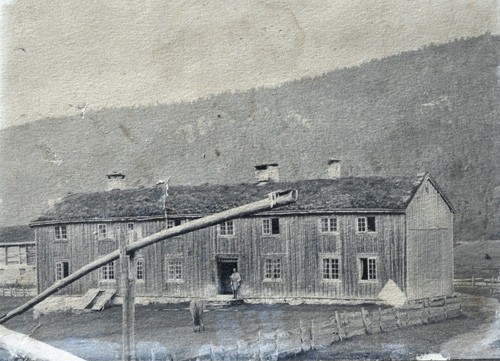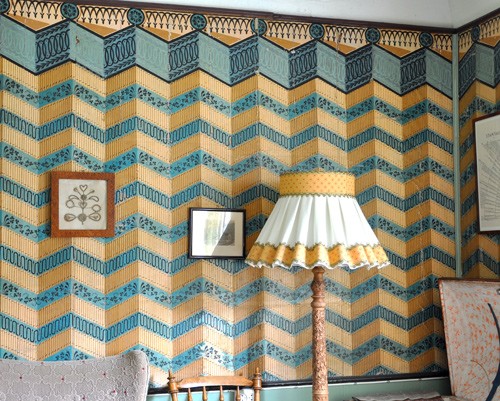Heinrich P. Bauer (1785 – 1863) had a history as a military surgeon in Germany and (as prisoner in) France during the Napoleonic era before he became medical officer for the Romsdal Corps and settled in the Surnadal valley in the Nordmøre region. Here, he renovated a farmhouse, and the wallpaper he used can be seen in the living room at the farm to this day. Bauer’s history is more glorious than what local historians have given him credit for.

The Austistua Moen farm around 1900. The contrast between the exterior of the house and the elaborate living room at the farm must have been seen as considerable. The living room with the wallpaper is on the ground floor to the right. Photo: Unknown
During an assignment in Surnadal I was contacted by Ingebrigt B. Moen who is currently living at the Austistua farm. He told me about Dr Bauer and mentioned that they had preserved the wallpaper that the doctor had used to decorate the living room when he still lived at the farm.
In the early 19th century there were four doctors in Romsdals Amt, as Møre og Romsdal county was called at the time. One of them was medical officer of the Romsdal Corps, Heinrich Philip Bauer, who practised in Surnadal from 1833 (1, 2).
Local historian Hans Hyldbakk (3) writes the following about him:
«He was said that to have fled from the war in his home country. After coming to our village, he became doctor to the soldiers at Skeismoen, but he was not reputed to be an excellent doctor. He was said to use mostly cold water for treatment, and for this reason he was mostly referred to as Cold-Water Baur. (…) It was Bauer who renovated them (the farmhouses) with wallpaper and panelling all over. It was he who also built the exemplary potato cellar under the houses, topped by a stone vault.»
For the occasion, we also reproduce the information on Dr Bauer in the reference work Norges Leger (Doctors of Norway) (4) (rendered in the language of 1873):
«Bauer, Heinrich Philip, 1785 – 1863, army medical officer. He was born in Osterode am Harz on 17 March «1785», participated as field surgeon in the French-German wars at the time of Napoleon and was taken prisoner by the French led by Bernadotte in Hamburg. During his six months of captivity he served as doctor to the French forces. On the occasion of the war with Sweden in 1808 he was engaged by the Sanitary College in Kiel as doctor to the Army of Norway and arrived in Christiansand in July of the same year. During the war years 1808 – 1814 he served in several locations of Southern Norway, first as company surgeon and from 4 August 1811 as battalion surgeon to the 2nd Throndhjem Infantry Regiment, in 1818 as battalion surgeon to the Romsdal National Corps of Musketeers, and in the year 1819 he was appointed corps surgeon to the same division. From this position he was granted discharge with a pension on 26 May 1855. From 1811 to 1833 he resided in Ørkedalen (the Orkdal valley, author’s note), with the exception of two periods (the last time in 1827) during which he administered the Christiansund City Medical Office during vacancies. From 1833 he lived in Surendalen, where he died on 12 June 1863. In his time, he enjoyed considerable trust in his abilities as a doctor, not least as accoucheur (male midwife, obstetrician; author’s note), and he is said to have been in possession of extraordinary physical strength.»
This description adds nuances to the impression of Bauer that Hans Hyldbakk presents in his Gards- og ættesoge for Surnadal (The history of Surnadal farms and lineages) (3). It confirms also that Bauer must have stayed in contact with German, French, Dano-Norwegian and Swedish communities that were well versed in contemporary fashion and architecture, and that he had a position that provided him with a financial basis for the modernisations that he undertook of his house in Surnadal.
Wallpapers for decoration of walls were developed from the 16th century and spread among the well-off all over Europe. Patterns often included flowers, garlands and bands of stylised flowers, or more geometric patters or imitations of stonework. Some had also pictures of daily situations, natural scenes or people. Some were hand-painted, but block printing with different colours gradually became common. Initially, subdued natural colours tended to be used, but chemists gradually developed artificial dyes that were brighter and more resistant to fading.
The first half of the 19th century has been described as the golden age of wallpapers, especially in France. From this period we have bold colour combinations, such as orange and lurid Schweinfurt green (5), chrome yellow and blue. Finishing the wall decoration with a band along the top was another element which is typical of the period (6). In more grand halls, the wallpaper patterns were in the form of draperies, designed true to nature and with a three-dimensional effect, as illustrated in a comprehensive British presentation (7). Towards the 1850s the colours became somewhat more subdued, and the patterns left the Empire mould, returning to old style elements from the Renaissance, Baroque and Rococo in a modernised and adapted form.
On a question to Das Deutsche Tapetenmuseum, Dr Astrid Wegener replied (personal communication):
«The wallpaper is a beautiful specimen from the Empire period 1800 – 1810. The famous German wallpaper manufacturer Johann Christian Arnold in Kassel made similar designs, although not this one. The design may possibly also be French. I have submitted the issue to my French colleague Bernard Jaqué. He deems it to be of French origin and dating from 1805 – 1810.»
The wallpaper from Austistua farm is thus an Empire wallpaper with a stylised drapery motif, as was the fashion during the first half of the 19th century. The assumption that it was Dr Bauer who decorated his living room with this wallpaper can thus be supported in light of what we know about his profession and places of residence.

The picture shows the wallpaper at Austistua farm as it appears today. Photo: Dag Brekke
The time and place where Bauer bought his wallpaper are left for speculation. However, at the time when the wallpaper most likely was made, he was in German-French service and may have obtained the necessary contacts. Bauer’s history may thus be more glorious than what local historian Hans Hyldbakk gives him credit for.
